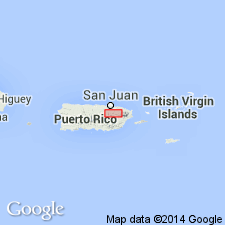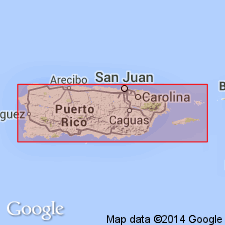
- Usage in publication:
-
- Pajaros Tuff*
- Modifications:
-
- Named
- Biostratigraphic dating
- Dominant lithology:
-
- Tuff
- AAPG geologic province:
-
- Caribbean region
Summary:
Pajaros Tuff, here named, consists of thin-bedded, fine-grained tuff with interbeds of massive tuffaceous wacke and coarse-grained lapilli tuff. Partly altered to hard jasperoid with pyrite. Basal unit of a conformable sequence of rocks in northern Naranjito quad; base concealed by unconformably overlying strata of Oligocene age or younger. Maximum thickness is 580 m. Age is late Early Cretaceous to early Late Cretaceous with biostratigraphic evidence for an age of Coniacian or Santonian. Correlates with the tuffaceous strata of the Robles Formation.
Source: GNU records (USGS DDS-6; Reston GNULEX).

- Usage in publication:
-
- Pajaros Tuff*
- Modifications:
-
- Overview
- AAPG geologic province:
-
- Caribbean region
Summary:
The Pajaros Tuff occurs in eastern Puerto Rico and consists of tuff, tuffaceous siltstone, and sandstone. Maximum exposed thickness is 580 meters. The Pajaros is of Early(?) Cretaceous age.
Source: GNU records (USGS DDS-6; Reston GNULEX).
For more information, please contact Nancy Stamm, Geologic Names Committee Secretary.
Asterisk (*) indicates published by U.S. Geological Survey authors.
"No current usage" (†) implies that a name has been abandoned or has fallen into disuse. Former usage and, if known, replacement name given in parentheses ( ).
Slash (/) indicates name conflicts with nomenclatural guidelines (CSN, 1933; ACSN, 1961, 1970; NACSN, 1983, 2005, 2021). May be explained within brackets ([ ]).

